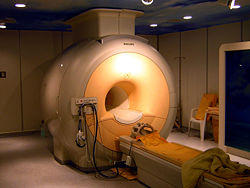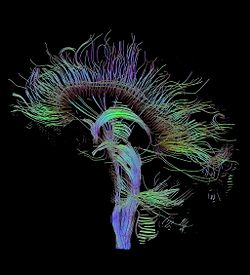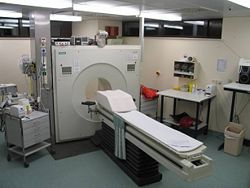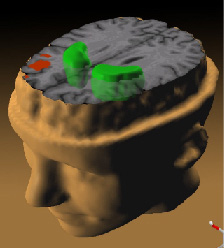Neuroimaging: Difference between revisions
imported>Daniel Mietchen |
mNo edit summary |
||
| (5 intermediate revisions by 3 users not shown) | |||
| Line 1: | Line 1: | ||
{{Subpages}} | {{Subpages}} | ||
{{Image|Neuroimaging workflow.png|right|600px|A typical [[workflow]] of a neuroimaging study: Data obtained by a neuroimaging technique and some other means (here: a [[questionnaire]] and [[DNA sample]]s) are analysed for [[statistical correlation|correlation]]s between the variables, and the results plotted on a representation of the brain, often a [[brain atlas]].}} | |||
'''Neuroimaging''' is a collective term referring to any methodology that provides a visualization of the structure or function of elements of the [[nervous system]], though with a strong focus on [[in vivo]] methods and the [[brain]]. | |||
= Neuroimaging techniques = | = Neuroimaging techniques = | ||
| Line 28: | Line 32: | ||
Different types of tissue have influence on these relaxation times, producing contrast in pictures of different tissue. | Different types of tissue have influence on these relaxation times, producing contrast in pictures of different tissue. | ||
Tomographic 3D-information is gathered by coding spatial information in gradient fields. These are | Tomographic 3D-information is gathered by coding spatial information in gradient fields. These are overlaid on the external field and thereby modify the lamour frequency. | ||
== Diffusion-tensor MRI == | == Diffusion-tensor MRI == | ||
| Line 50: | Line 54: | ||
{{Image|Schizophrenia glutamate.jpg|right|350px|An fMRI study of patients with schizophrenia. While they performed a working memory task, the less the prefrontal cortex (red) activated, the more dopamine increased in the striatum (green).}} | {{Image|Schizophrenia glutamate.jpg|right|350px|An fMRI study of patients with schizophrenia. While they performed a working memory task, the less the prefrontal cortex (red) activated, the more dopamine increased in the striatum (green).}} | ||
Active regions in neural tissue show an increased blood flow. This results in a higher oxygenation | Active regions in neural tissue show an increased blood flow because of the oxygen requirements of neural cells. This results in a higher oxygenation level in the blood from those regions. Because of the different magnetic susceptibility of oxygenated and deoxygenated blood, these differences are calculated and made visible via MRI methods. The signal being measured is called the blood-oxygenation level dependent (BOLD) signal. It is often used in research to measure the reaction of the brain to certain stimuli or actions. | ||
= Data processing issues = | = Data processing issues = | ||
| Line 60: | Line 64: | ||
== Brain atlases == | == Brain atlases == | ||
For proper comparison between results of scientific studies one needs a method to locate e.g. areas of activity in a fMRI study. Brain atlases are a way to improve the comparability and indexing of study results. | For proper comparison between results of scientific studies one needs a method to locate e.g. areas of activity in a fMRI study. Brain atlases are a way to improve the comparability and indexing of study results.[[Category:Suggestion Bot Tag]] | ||
Latest revision as of 06:00, 25 September 2024
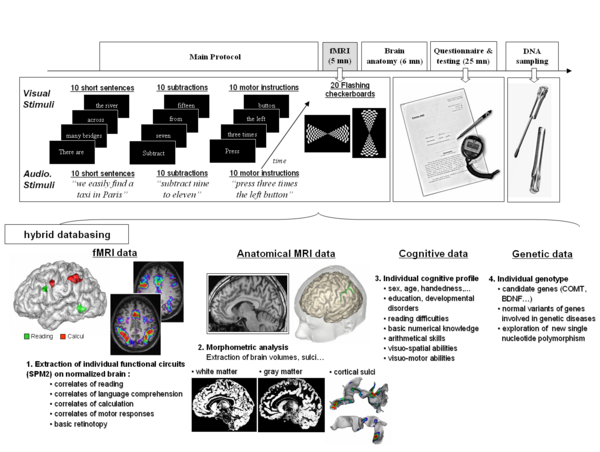
A typical workflow of a neuroimaging study: Data obtained by a neuroimaging technique and some other means (here: a questionnaire and DNA samples) are analysed for correlations between the variables, and the results plotted on a representation of the brain, often a brain atlas.
Neuroimaging is a collective term referring to any methodology that provides a visualization of the structure or function of elements of the nervous system, though with a strong focus on in vivo methods and the brain.
Neuroimaging techniques
The aim of neuroimaging methods is to produce images of the brain or to visualize brain activity. The two major fields are structural and functional imaging. Many different methods (colloquially referred to as brain scans) are used for this purpose, including
- Electroencephalography (EEG)
- Magnetoencephalography (MEG)
- Positron emission tomography (PET)
- Magnetic resonance imaging (MRI)
- Functional magnetic resonance imaging (fMRI)
Structural neuroimaging
MRI
Protons ()are particles with Spin . In a strong external Magnetic field they tend to line up with the field. The underlying effects can strictly be described only by the means of quantum mechanics. Nevertheless it is possible to imagine the mechanism via classical analogies.
The protons can be compared to a classical solid top. When a rotating solid top in a homogeneous gravitational field is not perfectly aligned with the vertical axis of the field, it starts a precession movement around this axis. Similarly the proton spins are preceding in the magnetic field with a characteristic frequency—the lamour frequency.
It is now possible to excite the proton spins by a RF pulse. Excited spins are not aligned with the external field any more, but are preceding in the xy-plane in a coherent way. This precession movement induces a measurable signal in a detection coil. When the RF pulse is stopped, 2 decay processes begin and the corresponding decay times are measured.
- Spin-lattice-relaxation (), longitudinal relaxation: The spins realign with the external field.
- Spin-spin-relaxation (), transverse relaxation: The spins precession movement is dephased and becomes incoherent.
Different types of tissue have influence on these relaxation times, producing contrast in pictures of different tissue.
Tomographic 3D-information is gathered by coding spatial information in gradient fields. These are overlaid on the external field and thereby modify the lamour frequency.
Diffusion-tensor MRI
By applying a special gradient to the magnetic field the diffusion of water can be imaged. To get 3D diffusion information a series of measurements with different gradient directions has to be performed. From this diffusion data one can reconstruct the directions of fibers by a method called white matter tractography. This is necessary to create connectivity graphs of the brain.
Functional neuroimaging
Functional neuroimaging is used to image metabolic activity in neural tissue.
Positron emission tomography
Radioactive labels are injected into the human body. In their decay they emit gamma-rays. These are measured and the source is localized by tomographic reconstruction.
Functional MRI (fMRI)
Active regions in neural tissue show an increased blood flow because of the oxygen requirements of neural cells. This results in a higher oxygenation level in the blood from those regions. Because of the different magnetic susceptibility of oxygenated and deoxygenated blood, these differences are calculated and made visible via MRI methods. The signal being measured is called the blood-oxygenation level dependent (BOLD) signal. It is often used in research to measure the reaction of the brain to certain stimuli or actions.
Data processing issues
Data provenance
To be useful as data resource in scientific collaborations, the history of images has to be tracked. This is called "provenance" (also "lineage" or "pedigree"). Provenance consists of the data part and the process part. The data provenance contains information about the origin of raw images, while the process provenance documents the way those images have been manipulated.
Brain atlases
For proper comparison between results of scientific studies one needs a method to locate e.g. areas of activity in a fMRI study. Brain atlases are a way to improve the comparability and indexing of study results.
